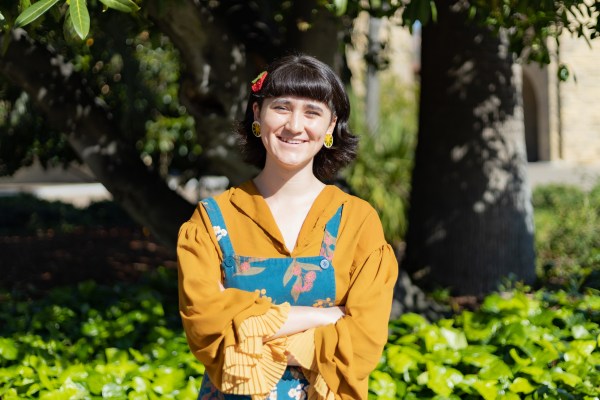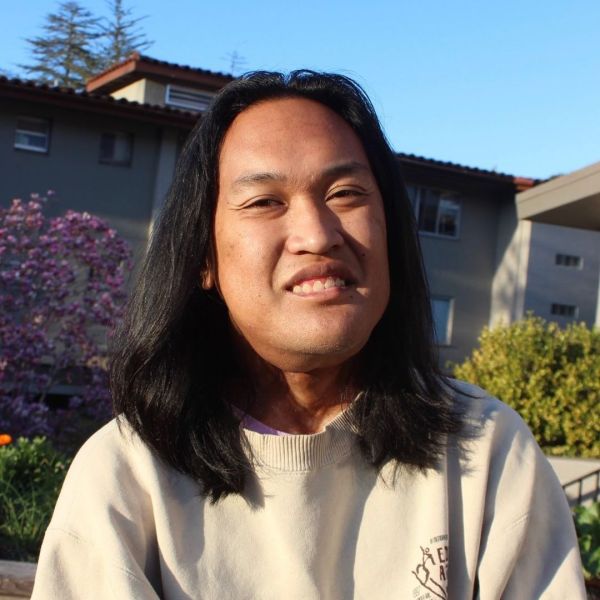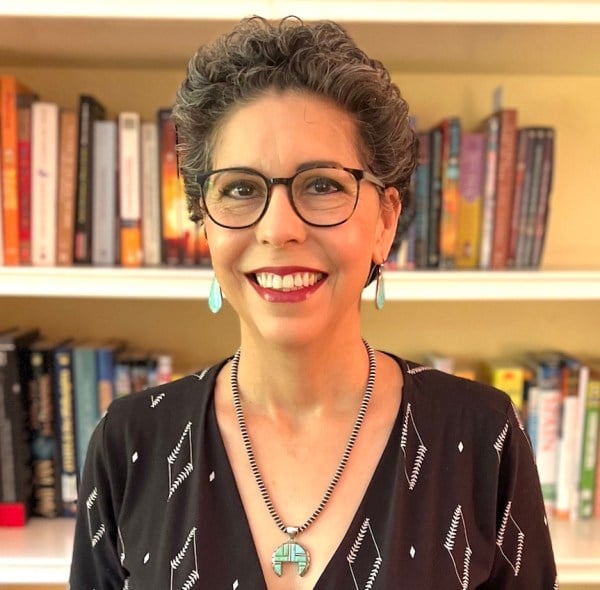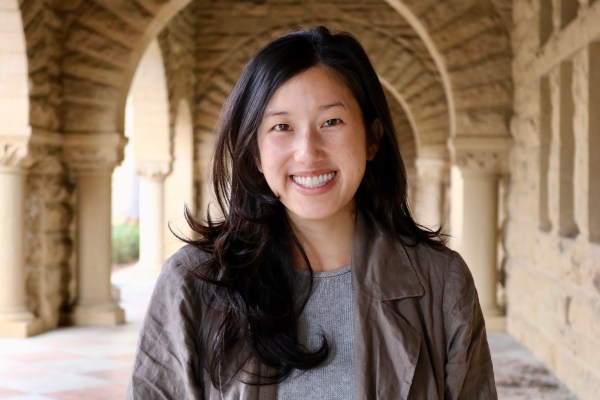From Left to Right: Thaomi Michelle Dinh, Keoni Rodriguez, Huali Kim-O’Sullivan, Paula Moya (Graphic: CARLOS RODRIGUEZ / The Stanford Daily)
Like many other students, Huali Kim-O’Sullivan ’23 arrived at Stanford unsure of what she wanted to study. Initially drawn to the history major, she soon began to feel disconnected and restricted by the department’s framing of historical periods and objectivity.
“I just realized, ‘Oh, this is not what I’m looking for,’” Kim-O’Sullivan said. She was not only looking to examine past societies. “Specifically, [I wanted] critical thinking about my community and our struggles.”
She felt her frustrations become starkly clear when she took COMPLIT 149: “The Laboring of Diaspora & Border Literary Culture,” which was cross-listed with the Comparative Studies in Race and Ethnicity program (CSRE). Compared to the history department, Kim-O’Sullivan felt that the CSRE program’s flexible structure gave her more agency to conduct directed research on specific topics.
The history department did not respond to the Daily’s request for comment.
In addition to more adequately addressing her research concerns, Kim-O’Sullivan also said she found CSRE’s intersectional approach afforded greater nuance and depth to non-western areas of study — crucial support for her interest in the native Hawai’ian diaspora.

“Once I entered that space, it was a lot more comfortable for me to advocate for myself and what I wanted to get out of the classroom,” she said.
She is not alone. Earth Systems coterminal student Keoni Rodriguez ’22 M.S. ’23 majored in history as an undergraduate, but their minor and honors thesis were in CSRE. For them, the CSRE program’s strengths lie in offering greater methodological flexibility and a subject focus in Native American Studies, which led them to conduct their honors thesis in this program.

Despite choosing to major in history, Rodriguez also came to prefer the critical lens of CSRE over that of their history major. At the same time, they lamented the University’s treatment of ethnic studies, saying, “When it comes to institutional support, Stanford lags way behind.”
But students aren’t the only ones impacted — faculty are also feeling the effects of a CSRE program that is stretched thin. As a program, CSRE is an umbrella that houses Chicano/Latino Studies (CHILATST), Asian-American Studies (AAS), Native American Studies (NAS), Jewish Studies and more broad ethnic studies pathways. While some programs like African and African American Studies (AAAS) are receiving departmentalization after years of student activism, the remaining CSRE programs continue to struggle in staffing and meeting the needs of students.
“[The lack of departmentalization] is exactly the problem,” Center for Comparative Studies in Race and Ethnicity Director Paula Moya said.
With the AAAS department slated to officially begin in 2024, students and faculty have expressed hope that the remaining CSRE programs will follow the lead of AAAS and get departmentalization.
According to education professor and CHILATST director Jonathan Rosa, all non-departmentalized CSRE programs are considered interdisciplinary programs (IDP).
The interdisciplinary aspect is part of what makes CSRE a unique program. Stanford spokesperson Joy Leighton noted that the interdisciplinary nature of CSRE programs is valuable because “it is able to draw faculty from different disciplines into one major.”
“Studying within an IDP, students are free of traditional disciplinary boundaries and can work with faculty across the school from different departments, such as English, history, psychology, and political science,” Leighton said in a statement to The Daily.
However, faculty have also noted that there are challenges to operating as an IDP rather than an academic department.
Since they are not departments, these programs are not allowed to hire their own faculty. In other words, staff who get hired to work exclusively for CSRE programs do not get offered full-time tenure positions. As for full-time professors who teach CSRE courses, these faculty members are housed in other departments and choose to teach within CSRE.
Rosa himself is officially housed in the Graduate School of Education. This means that his full-time job is within that department, according to Rosa. He noted that, scrolling through the affiliated faculty webpage for CSRE, there are hundreds of staff listed, which gives the illusion that CSRE has a lot of faculty. However, he pointed out that they are all labeled as affiliated faculty because they are actually housed in other departments.
“My work within CSRE is above and beyond – in many ways– my full-time job,” Rosa said. “All of those people – their primary job is elsewhere on campus,” Rosa said.
This means that professors only contribute to CSRE programs when they have the capacity to do so. “It essentially makes CSRE into volunteer work that people do or into this kind of extra work that people are doing, taking on above their already existing responsibilities,” Rosa said.
He added that, because of the program’s current structure, “it’s really difficult to have people contribute and become regular contributors because they’re already doing so much work elsewhere on campus.”
Rosa further noted that CSRE lacks the power to hire scholars whose education and knowledge rests primarily in ethnic studies. Rather, CSRE-affiliated faculty are often trained in other fields of study, like political science, anthropology and sociology. He added that this impedes the program’s ability to develop a strong ethnic studies curriculum for students.
According to Moya, this issue could be addressed if CSRE was departmentalized, which would allow current CSRE-affiliated faculty to formally move some of their responsibilities into ethnic studies. This way, the CSRE work could count toward their contractual obligations rather than being extraneous labor.

Last year, the Center for Comparative Studies in Race and Ethnicity (which helps run the CSRE programs) was given the green light and funds by the School of Humanities and Sciences to hire an associate director for three of its programs. This position was created to foster community among the various academic programs in CSRE and address criticism from students and faculty for its limited course options and teaching staff inconsistency.
Yet the search for the position for each program – AAS, CHILATST and NAS – has been challenging, with only AAS successfully fulfilling the position as of spring quarter.
This associate director is expected to teach four classes a year within their program, one of which is mandated to be an introduction course, Moya said. They will also contribute to administrative aspects of the program, help develop the curriculum and organize CSRE events. Although associate directors contribute a significant amount of work to the CSRE programs, there are no structured opportunities for associate directors to then get hired for a tenured faculty position.
AAS began its search for an associate director last year and hired Thaomi Michelle Dinh, who began her position this past fall. However, the search for CHILATST and NAS associate directors has proven to be more difficult, according to Moya.
Though Moya expressed excitement about these positions, she noted that filling these spots has been difficult because it requires the “right person” willing to teach courses without having an official faculty title.
Currently, the associate director position is the only way to hire a person to teach full-time in a CSRE program. Often, potential candidates for this position prefer to teach as official faculty since a faculty position would mean opportunities for a professorship. As a result, the limits of the associate director position dissuade them from applying.
“Finding the right person is key, which is why the searches have not yielded,” Moya said. “What [we] want is somebody who is a really excellent teacher but for some reason or another may not want to go on and do a faculty job. And so it’s that sweet spot between having an excellent teacher and someone who doesn’t want to be faculty because these are not faculty positions.”
For Dinh, though, the lack of a faculty title was no deal-breaker. On the contrary, the pedagogical focus drew her to apply for the job. She was responsible for teaching AMSTUD 100: “Introduction to Asian American Studies” this winter and is currently teaching a spring course on sexual violence in Asian America.
The associate director position also allows her to conduct research at a self-guided pace, rather than working toward the specific demands associated with the tenure track. Engaging with students within ethnic studies this year has even helped guide her research work.
“A lot of the times when I’m teaching something, it’ll also be about something I’m doing research on. So, [for instance,] I have an article coming out this year on sexual violence, and that’s something I’m going to be talking about in my class. And so it’s nice to be able to figure out how to do that, too,” Dinh said.
Aside from AAS, Jewish Studies is the only other program that has been successful in hiring an associate director. Shaina Hammerman currently serves in that role and began working for the Jewish Studies program in 2020.
However, according to some in CSRE administration, the programs that still lack an associate director are feeling the effects of this gap.
Karen Biestman, who serves as the associate dean and director of the Native American Cultural Center, is currently fulfilling 25% of the duties of the NAS associate director position until a permanent candidate is chosen. Though the original search for a NAS assistant director failed, it was recently relaunched with broader outreach and has yielded promising leads, Moya said.
The CHILATST associate director position search also failed and is currently stalled. CSRE staff are in the process of reassessing the search process and hope to relaunch the search at some point in the future.
These associate directors’ positions have broad and complex administrative and instructive roles. Additionally, each ethnic studies program also has a faculty program director. For AAS, the program director position is filled by tenured music professor Stephen Sano.
Dinh explained that although Sano manages to keep up a high level of involvement in the organization of AAS, his primary job responsibilities still lie in his home department of music. However, Dinh notes that her sole responsibility is to AAS, which allows her to focus all of her energy on the program.
“It’s helpful to have a designated person who’s just taking care of the program,” Dinh said. “So whether that means answering specific questions about the program, teaching Asian American Studies-specific classes, or putting on Asian American-specific programming that becomes really valuable.”

Having an associate director allows the program to have more hands on deck — a crucial need for any academic program. For CSRE, the need for dedicated staff is even further exacerbated by the nature of its status within the University as a program rather than a department.
Moya noted that as long as departments are deeply integrated into the University’s structure, “It puts IDPs, especially IDPs like CSRE, at a real disadvantage because we don’t have our own faculty energy to draw on and we can’t hire.”
With several key roles empty, it is more difficult for CSRE to fully develop its program offerings, such as creating consistent curriculums.
This is particularly troubling — Moya notes — because of the continuously increasing interest in ethnic studies among Stanford students. This year, the enrollment for the introductory CSRE class was capped at 130 students, which is up from 60 students the previous year.
Kim-O’Sullivan believes that this increased interest is the case because CSRE programs don’t merely describe pressing contemporary issues; rather, she sees it as a fundamentally action-based discipline.
As a result, she said, it acts as a “hub” of sorts for scholarly activism.
Secondly, she said that CSRE affirms marginalized students’ experiences by validating non-traditional research methods, as opposed to the conventional procedures that are often rooted in colonialism. This expansive aspect of CSRE is also reflected in Rodriguez’s experience.
Rodriguez’s honors thesis, which was housed within CSRE, was both an exploration of non-western historical methodologies and a study on Hawai’ian diasporic experiences. The thesis used Kanaka Maoli historical methods (such as spirituality) in combination with standard archival and ethnographic methods.
According to Rodriguez, CSRE made it possible for them to incorporate the non-western historical practices that “might not be taken seriously in a capital-H ‘History’ context,” yet are central to understanding Kanaka Maoli knowledge production.
Kim-O’Sullivan’s senior capstone project, a script for a comic book about diaspora and Indigenous spirituality, highlights what she sees as another unique strength of CSRE.
“Students in CSRE have a lot of ability to combine all their interests into one cohesive narrative,” she said. In her case, this meant the synthesis of dual passions for history and art.
Rodriguez said that outside of CSRE, very few places on campus can offer this access to interdisciplinary methodologies — namely AAAS, human biology and feminist, gender, and sexuality studies.
“The situation, as I see it now is, that many IDPs have more students than departments do,” Moya said. “I think part of what we’re seeing is a transformation in the structure of the University that is not being adequately recognized by the University structure that privileges departments.”
Leighton acknowledged Moya’s points, noting that students are increasingly seeking out “interdisciplinary opportunities of study since most of the popular majors in H&S are IDPs.”
“As we are in the process of standing up a new institute for the study of race, we see many opportunities to add institutional support to our excellent departments, programs, and centers focused on social issues of race and ethnicity,” Leighton said.
Kim-O’Sullivan added that departmentalization would open up graduate student positions in CSRE, bolstering possibilities for scholarship and facilitating teaching assistance for faculty.
However, Kim-O’Sullivan notes that CSRE departmentalization is an imperfect solution and should act as an example of gradual change. In her ideal world, history and other departments would already reflect the realities of marginalized students, namely by investing ample resources into non-western areas of study.
Given the immediate reality, though, Kim-O’Sullivan and Rodriguez are in agreement on the need for departmentalization.
In Rodriguez’s words: “That is the next step in terms of being able to support ethnic studies.”
A previous version of this article misidentified the School of Humanities and Sciences as the Department of Humanities and Sciences. The Daily regrets this error.
Itzel Luna '25 is a Vol. 266 Executive Editor. Luna is originally from the San Fernando Valley in Los Angeles and is majoring in Sociology on the data science, markets, and management track.
Contact her at iluna 'at' stanford.edu
Contact The Daily’s Arts & Life section at arts ‘at’ stanforddaily.com.